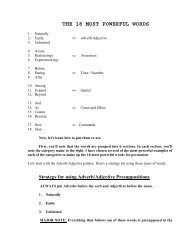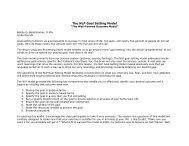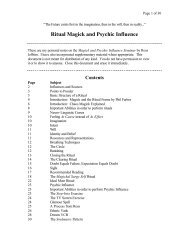A Pragmatic Guide To Communication & Change.pdf - NLP Info Centre
A Pragmatic Guide To Communication & Change.pdf - NLP Info Centre
A Pragmatic Guide To Communication & Change.pdf - NLP Info Centre
- No tags were found...
You also want an ePaper? Increase the reach of your titles
YUMPU automatically turns print PDFs into web optimized ePapers that Google loves.
of the verb in a sentence rather than doing the action of the verb. You may recognize<br />
this pattern as being typical of someone who is depressed. Statements like "Nobody<br />
cares about me," and "I sometimes think everyone is out to get me," are examples of this<br />
pattern. In both sentences, the speaker has removed himself from a position of being "in<br />
charge" of the action and has given the power of acting to someone else. The "me," or<br />
speaker, then becomes a helpless victim of whom or whatever is in charge. This is a<br />
common pattern used by individuals operating from the kinesthetic system.<br />
The illustration below shows another aspect of this violation. Not only does the man<br />
apparently perceive himself as powerless, but he also fails to recognize that he is doing<br />
the very thing he is complaining about.<br />
Reversed Referential Index<br />
The famous Gestalt therapist Fritz Perls called this linguistic pattern "projection." As<br />
Martin Shepard says in her book Fritz, on Page 205...... whatever we believe about or<br />
see in another person or the world at large is invariably a projection. Thus a statement<br />
such as 'Nancy is a gossip' was to be rephrased as 'I am a gossip.' " She goes on to say<br />
that, as people begin to take responsibility for themselves this way, ". . they have the<br />
possibility of having an 'Aha" experience, in which there is the recognition 'This is me!'<br />
This is referred to as oeuning projections."<br />
83<br />
By requiring his clients to reverse positions and become the "active" agent in the<br />
sentence, Fritz Perls would put the clients back in charge of the processes of their own<br />
existence. This transformed perception of themselves often produced some surprising<br />
insights into the model-building behaviors of his clients.<br />
Other examples of this reversal technique are:<br />
Speaker: "tie's no good for me."<br />
Response: "Try saying, 'I'm no good for him,' and tell me what you experience."<br />
Speaker: "Everybody hates me."<br />
Response: "Try saying this. 'I hate everybody."<br />
Speaker: "Nobody loves me."<br />
Response: "Can you say `I love nobody?"'<br />
Another form of this violation is often demonstrated by people operating out of the<br />
visual communication category. Remember that "visuals" organize experiences in such<br />
a way as to prevent "contact" with those around them. One way of maintaining this<br />
distance is with the linguistic pattern of reversed referential index. The Meta Model<br />
response to these violations will be the same as those above, and you will likely get the<br />
same results, the introspective "Aha!"<br />
Examples of this form are:<br />
Speaker: "He never seems to understand me."<br />
Response: "I wonder if you would mind saying, 'I never seem to understand him.'<br />
"<br />
Speaker: "She's the one who always seems to get us into these messes.' "<br />
Response: "Would you mind saying, 'I'm the one who always get us into these<br />
messes'?' "<br />
ao
















